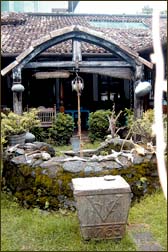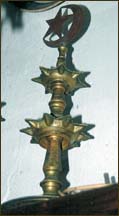by ASIFF HUSSEIN
It is perhaps Sri Lanka’s largest private museum with a priceless collection of antiques and trivia going back to centuries, but the Historical Mansion Museum as it is called had a very humble origin.

It was a little over a decade ago that its owner Abdul Gaffar inspired by the Salarjung Museum in Hyderabad which houses the private collection of the Nizam’s Prime Minister Nawab Ali Khan, set about building his own museum over the ruins of an old Dutch-era house he had purchased at Leynbaan Street in the heart of Galle Fort.
The building, with its characteristic Dutch central courtyard was restored to its present state with great pains, even to the extent of employing a mixture of clay and coral in the restoration of its walls in keeping with the original. Perhaps the most fascinating feature of the museum is an old Dutch well in the central courtyard with a stone slab inscribed with the monogram of the Dutch East India Company VOC and dated 1763. The exhibits are of course Abdul Gaffar’s very own private collection collected with great care over a period of about 40 years.
Lost handicrafts
Galle was once renowned for a number of cottage industries some of which no longer exist. These include handicrafts made of turtleshell, buffalo horn and porcupine quill, many specimens of which could be seen in the museum.
Among the turtleshell ware displayed here one would come across jewellery such as bangles and earrings, combs, pill boxes, handbags and a heramitiya or walking staff. Items turned out of buffalo horn include a box, fork, combs, mirrors and ornamental birds while among the items made of porcupine quill may be included miniature tables and ash trays.
Such items are no longer freely available in the market. For instance, the art of manufacturing items out of turtle-shell is all but extinct today as turtles have been declared a protected species. The craft involved heating the turtleshells until they softened after which they were cut into little pieces and placed in a mould to obtain the desired shape.
Also displayed here are some fine specimens of beeralu lace. The art of beeralu-making introduced by the Portuguese is traditionally passed down from mother to daughter and still survives in Galle and Weligama though not on the scale one would have expected to find it a century or so ago.
Among the other exhibits on display one would find a few items going back to the Dutch period.
These include Chinese porcelain plates in blue and white bearing the VOC monogram. More recent however is a porcelain plate in red, green and blue, the bourenbund or farmer’s colours of Holland. Other interesting exhibits include an old willow pattern plate from Britain depicting a countryside scene with a willow tree, cottage, bridge and boats and a food warmer with floral designs said to have been manufactured at Stoke-On-Trent.
Other notable porcelain items include some old kettles, vases and a teacup with the head of Queen Elizabeth II and the Union Jack commemorating her coronation on June 2,1953.
Old lamps

Pix :Tilak Perera
One would also find here a good collection of old lamps including a house lamp, fisherman’s lamp, train lamps as well as a variety of oil lamps including one surmounted by a crescent and star which was probably in use among the Muslims.
Also to be seen are some very old oil lamps made of granite. Besides these, one would find an old hookah pipe known among local Muslims as the gudakku. The Moorish women of yore like their Arab sisters were in the habit of smoking these pipes until fairly recent times though the practice is said to have considerably declined of late. It is hardly if ever indulged in nowadays.
Other interesting exhibits include an old ice cream or butter churning machine, a rather unusual skeletal chair made of tree roots and some snake boxes used by snake charmers. There are besides these some old swords, pistols, knuckle-dusters and bullets.
One would also come across a good collection of miscellaneous antique items, some of which may go back to over a century. Especially interesting are the old smoothing irons used with coal of which there are about a dozen.
Besides these there are also old gramophones including a particularly old one with a cabinet which may go back to about a century as well as some old telephones including one made of metal and beige ceramic and some old sewing machines which appear rather crude when compared to the modern thing. Among the other interesting exhibits are some old cameras including a very old Kodak box camera, old typewriters including a rare Remington and some old radios including a large Philips radio in use around the 1950s or thereabouts.
Also displayed here are a variety of old trivia including antiquated hospital items like stethoscopes and delivery forceps and a few feeding bottles shaped like almonds which were in use until about the 1960s or thereabouts. Other notable trivia include an old pipe holder with pipes, cigarette lighters, pens, spectacles and an assortment of snuff bottles, some multi-coloured, some with human figures and one with the figure of a horse.
 Asiff Hussein – Asiff Hussein Web Site
Asiff Hussein – Asiff Hussein Web Site




